OSPREY ROUNDUP 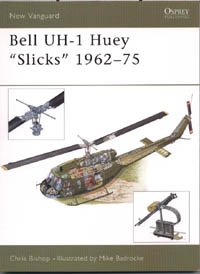 New Vanguard 87, Bell UH-1 Huey "Slicks" 1962-75, by Chris Bishop, illustrated by Mike Badrocke, ISBN 1-84176-632-1. New Vanguard 87, Bell UH-1 Huey "Slicks" 1962-75, by Chris Bishop, illustrated by Mike Badrocke, ISBN 1-84176-632-1.
The New Vanguard series expands to include aircraft! Well, the Huey is probably the best-known of all choppers for its Vietnam service and even armour modellers will concede that it was an Army vehicle. Here we get the story of its development from first origins to the highly-developed Air Cavalry helicopters with twin engines and door MGs. The dedicated gunships are not here, presumably to follow in a second volume. What you get here is a complete rundown on all the Slick variants, right up to the UH-1N, and a combat history. The comprehensive text is accompanied by a good set of photographs, and the plates show seven different sets of markings as well as the trademark New Vanguard cutaway. They cover not just US Army choppers but also Australian and Vietnamese examples and even one from the CIA's Air America. Recommended to all helicopter fans. 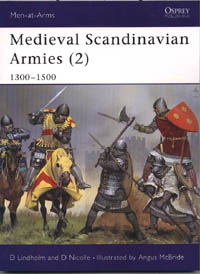 Men-at-Arms 399, Medieval Scandinavian Armies (2) 1300-1500, by D Lindholm & D icolle, illustrated by Angus McBride, ISBN 1-84176-506-6. Men-at-Arms 399, Medieval Scandinavian Armies (2) 1300-1500, by D Lindholm & D icolle, illustrated by Angus McBride, ISBN 1-84176-506-6.
The second part of this set is just as good as the first so if you're a figure modeller with a leaning towards medieval types don't just sit there, run out and buy it! In this period the Scandinavian kingdoms were still struggling for supremacy over each other, culminating in the Union of Kalmar which put Denmark at the top. Not surprisingly this was not exactly popular in the other countries and a number of revolts erupted. This book, though, concentrates on the arms and armour, tactics and fortifications rather than on the course of the fighting, and it covers these fields very well. The Nordic countries still tended to be behind the curve in military equipment, though some aristocrats were as well-armoured as their southern neighbours. The clear text is accompanied by interesting photographs of surviving armour, and Angus McBride's superb plates show what they looked like when worn. Very highly recommended. 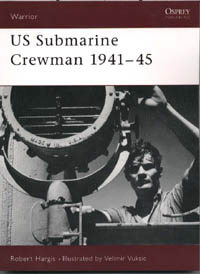 Warrior 82, US Submarine Crewman 1941-45, by Robert Hargis, illustrated by Velimir Vuksic, ISBN 1-84176-588-0. Warrior 82, US Submarine Crewman 1941-45, by Robert Hargis, illustrated by Velimir Vuksic, ISBN 1-84176-588-0.
Here we start with a brief look at US submarine actions in the Pacific theatre during WW2, with a chronology of notable events. Then there's a detailed look at recruitment and training, life in submarines, the experiences of various officers and men, leave and shore liberty, and finally how war patrols were carried out. All very well explained, with plenty of quotes from submariners. A good selection of photographs shows what they all looked like, just what figure modellers need to something a bit different from the usual "naval" figures seen on competition tables. Recommended. New Vanguard 88, British Battlecruisers 1939-45, by Angus Konstam, illustrated by Tony Bryan, ISBN 1-84176-633-X. 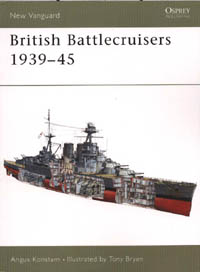 Who hasn't heard of the sinking of HMS Repulse by Japanese aircraft and the destruction of Hood by a magazine explosion in combat with the Bismarck? OK, this book will tell you about those actions. There were only six British battlecruisers during WW2, and their story begins before WW1 when the concept emerged of a ship class that would be too fast to be threatened by anything that mounted heavier guns but carry guns big enough to blow out of the water anything faster than itself. Armour was sacrificed to meet the needs for both speed and heavy armament. Despite the obvious lessons of Jutland, where the thinly-armoured battlecruisers proved horribly vulnerable to plunging fire, the type remained In service with no improvements to deck armour. Here you'll find the careers of all six of them, both before the war and in combat. Great reference photographs show them for ship modellers and the plates are very well done too. Recommended. Who hasn't heard of the sinking of HMS Repulse by Japanese aircraft and the destruction of Hood by a magazine explosion in combat with the Bismarck? OK, this book will tell you about those actions. There were only six British battlecruisers during WW2, and their story begins before WW1 when the concept emerged of a ship class that would be too fast to be threatened by anything that mounted heavier guns but carry guns big enough to blow out of the water anything faster than itself. Armour was sacrificed to meet the needs for both speed and heavy armament. Despite the obvious lessons of Jutland, where the thinly-armoured battlecruisers proved horribly vulnerable to plunging fire, the type remained In service with no improvements to deck armour. Here you'll find the careers of all six of them, both before the war and in combat. Great reference photographs show them for ship modellers and the plates are very well done too. Recommended.
 Men-at-Arms 398, The Texan Army 1835-46, by Stuart Reid, illustrated by Richard Hook, ISBN 1-84176-593-7. Men-at-Arms 398, The Texan Army 1835-46, by Stuart Reid, illustrated by Richard Hook, ISBN 1-84176-593-7.
This is not the story of the Texan war of liberation from Mexico but of the Texian army, though the main fighting actions are noted in the text. We get a look at the revolution itself and then the Texan Republic before the main part of the book covers the regular Army, Volunteer units of several kinds, and the Militia. The excellent text is accompanied by period illustrations and modern sketches drawn after other contemporary pieces. The flags are here too, and Richard Hooks' plates place him in the front rank of military artists. The plate captions are also exceptionally informative. If you love the Old West, are a figure modeller, or simply happen to be Texan and proud of it, this book is for you. Very highly recommended. 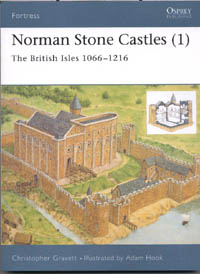 Fortress 13, Norman Stone Castles (1) The British Isles 1066-1216, by Christopher Gravett, illustrated by Adam Hook, ISBN 1-84176-602-X. Fortress 13, Norman Stone Castles (1) The British Isles 1066-1216, by Christopher Gravett, illustrated by Adam Hook, ISBN 1-84176-602-X.
To most of us the Norman castle is the quintessential castle. Stone walls, high towers, and the mighty keep - sound familiar? But there's far more to the story of Norman castles than that, they began with earth-and-wood fortifications and progressed to stone along a path that is set out clearly here. There are actually several distinct styles of Norman stone castle, beginning with a simple tower-keep which might only have a wooden palisade around it to begin with, then the more developed form with a stone surrounding wall. Next comes the type with towers on the wall and a gatehouse - but this wasn't always a process of improving an existing castle, the different types might be built at much the same time in different areas. The Tower of London and Dover Castle are both looked at In fair detail, with other castles examined too. The plates show the principles of their fortification, with fields of fire and suchlike clearly demonstrated. If castles fascinate you as much as they do me, and I've clambered around in most of those covered here, get this book! Highly recommended.  Fortress 14, Fortifications in Wessex c.800-1066, by Ryan Lavelle, illustrated by D Spedaliere & S S Spedaliere, ISBN 1-84176-639-9. Fortress 14, Fortifications in Wessex c.800-1066, by Ryan Lavelle, illustrated by D Spedaliere & S S Spedaliere, ISBN 1-84176-639-9.
What came before the Norman castles? The answer is here. Southern England was actually scattered with Saxon fortifications, though these were fortified towns rather than private, or even royal, castles. They were carefully chosen to provide refuge against Viking incursions and bases for flying columns to intercept the raiders. There's a surprising amount still to be seen, and a lot of it is set out here; though no book this size could cover all the sites in detail they are all listed and the best ones are given good descriptions as well as being illustrated. I haven't visited all of them myself, but I must tell you that one not to be missed if you're in the area is Portchester, near Southampton. Here there's a Roman fortress reused by the Saxons and with a Norman castle built into one corner - all three periods can be seen in one visit! The plates are very good, too, giving you a detailed look at the layouts of the towns covered. Here are some good ideas for groundwork if you want to produce a Saxon-period diorama for your figures. Recommended! 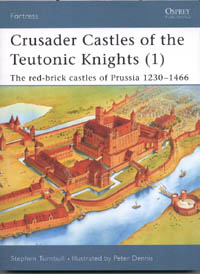 Fortress 11, Crusader Castles of the Teutonic Knights (1) The red-brick castles of Prussia 1230-1466, by Stephen Turnbull, illustrated by Peter Dennis, ISBN 1-84176-557-0. Fortress 11, Crusader Castles of the Teutonic Knights (1) The red-brick castles of Prussia 1230-1466, by Stephen Turnbull, illustrated by Peter Dennis, ISBN 1-84176-557-0.
Brick castles, I hear you ask? Yes, and by no means less formidable than those built of stone. The Teutonic Knights were ardently crusading to bring Christianity to the heathen tribes of Prussia and Poland, and built these castles as bases for their work. That was their story, anyway - the local people saw them as conquerors building a private empire. These castles seem quite different in concept to the Norman ones in England, though a closer look shows many similarities as well as differences. For one thing, the Knights had latrine towers discharging into rivers instead of cess-pits or no provision for hygiene at all! Many have gone now, torn down by attackers or by later developments, but others show quite well preserved remains. This book takes you around several, with modern photographs and a host of colour plates to show how they looked in their heyday. It's quite fascinating to anyone who's only seen the stone castles of England, and provides yet another set of ideas for displaying figures with realistic diorama bases - though most of the Teutonic Knights available commercially are the Grand Masters, conversion from "ordinary" knight figures won't be difficult. Recommended. 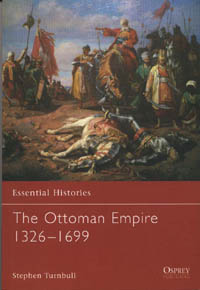 Essential Histories, The Ottoman Empire 1326-1699, by Stephen Turnbull ISBN 1-84176-569-4. Essential Histories, The Ottoman Empire 1326-1699, by Stephen Turnbull ISBN 1-84176-569-4.
Here's the story of Ottoman Turkish expansion following the fall of Byzantium, with their European and Middle Eastern conquests. Their final repulse from the gates of Vienna saw a gradual diminution of the empire begin, though they remained strong and conquered Egypt and what is now Saudi Arabia. Their inheritance today includes the terrible conflicts in former Yugoslavia, and anyone wanting to understand the background to these will find a lot to interest them in this book. The conversion to Islam were not all forced, and in some cases the local populations welcomed Turkish rule as a relief from their former overlords. In other cases the overlords invited Turkish alliance against their enemies. What a cat's cradle of alliances, betrayals and battles! Recommended to anyone with an interest in history.  Campaign 131, Tewkesbury 1471 The last Yorkist victory, by Christopher Gravett, illustrated by Graham Turner, ISBN 1-84176-514-7. Campaign 131, Tewkesbury 1471 The last Yorkist victory, by Christopher Gravett, illustrated by Graham Turner, ISBN 1-84176-514-7.
This was indeed a bloody battle, and it decided who sat upon the throne of England for half a generation. The background to the Wars of the Roses is not part of this story, which concentrates on the twin battles of Barnett and Tewkesbury. Their courses are described, and shown in bird's-eye views and maps as well as in the very good colour plates. There's a selection of contemporary illustrations, backed up by many new photographs of the battlegrounds and their surroundings. Excellent stuff for anyone who wants to know what happened before the rise of Richard III - Richard Hunchback as Shakespeare calls him.  Campaign 128, Quebec 1775 The American invasion of Canada, by Brendan Morrissey, illustrated by Adam Hook, ISBN 1-84176-681-X. Campaign 128, Quebec 1775 The American invasion of Canada, by Brendan Morrissey, illustrated by Adam Hook, ISBN 1-84176-681-X.
America invaded Canada in the belief that French-Canadians would welcome liberation from the British yoke. This turned out to be a bad mistake. The fighting included the unsuccessful American attack on Quebec and equally unsuccessful siege, followed by a miserable retreat and an epic waterborne battle on Lake Champlain. Everything is described here, with some great contemporary illustrations to back up the maps, bird's-eye views and colour plates. Highly recommended to everyone who'd like to know why Canada remained British.
| 








|